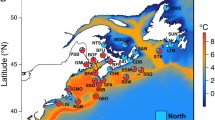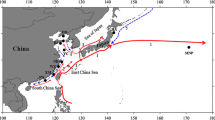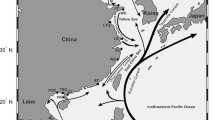Abstract
Marine scallops, with extended planktonic larval stages which can potentially disperse over large distances when advected by marine currents, are expected to possess low geographical differentiation. However, the sessile lifestyle as adult tends to form discrete “sea beds” with unique population dynamics and structure. The narrow distribution of Zhikong scallop (Chlamys farreri), its long planktonic larval stage, and the extremely hydrographic complexity in its distribution range provide an interesting case to elucidate the impact of marine currents on geographical differentiation for marine bivalves at a fine geographical scale. In this study, we analyzed genetic variation at nine microsatellite DNA loci in six locations throughout the distribution of Zhikong scallop in the Northern China. Very high genetic diversity was present in all six populations. Two populations sampled from the same marine gyre had no detectable genetic differentiation (F ST = 0.0013); however, the remaining four populations collected from different marine gyres or separated by strong marine currents showed low but significant genetic differentiation (F ST range 0.0184–0.0602). Genetic differentiation was further analyzed using the Monmonier algorithm to identify genetic barriers and using the assignment test conducted by software GeneClass2 to ascertain population membership of individuals. The genetic barriers fitting the orientation of marine gyres/currents were clearly identified, and the individual assignment analysis indicated that 95.6% of specimens were correctly allocated to one of the six populations sampled. The results support the hypothesis that significant population structure is present in Zhikong scallop at a fine geographical scale, and marine currents can be responsible for the genetic differentiation.



Similar content being viewed by others
References
An HY, Park JY (2005) Ten new highly polymorphic microsatellite loci in the blood clam Scapharca broughtonii. Mol Ecol Notes 5:896–898
Arnaud S, Monteforte M, Galtier N, Bonhomme F, Blanc F (2000) Population structure and genetic variability of pearl oyster Pinctada mazatlanica along Pacific coasts from Mexico to Panama. Conserv Genet 1:299–307
Avise JC (2004) Molecular markers, natural history, and evolution, 2nd edn. Sinauer, Sunderland
Baranski M, Loughnan M, Austin CM, Robinson N (2006) A microsatellite linkage map of the black lip abalone, Haliotis rubra. Anim Genet 37:563–570
Baus E, Darrock DJ, Bruford MW (2005) Gene-flow pattern in Atlantic and Mediterranean populations of the Lusitanian sea star Asterina gibbosa. Mol Ecol 14:3373–3382
Benzie JAH, Williams ST (1992) No genetic differentiation of giant clam (Tridacna gigas) populations in the Great Barrier Reef, Australia. Mar Biol 113:373–377
Bohonak AJ (1999) Dispersal, gene flow, and population structure. Quart Rev Biol 74:21–45
Brown B, Franklin DE, Gaffney PM, Hong M, Dendanto D, Kornfield I (2000) Characterization of microsatellite loci in the eastern oyster, Crassostrea virginica. Mol Ecol 9:2217–2219
Callen DF, Thompson AD, Shenm Y, Phillipsm HA, Richards RI, Mulley JC, Sutherland GR (1993) Incidence and origin of “null” alleles in the (AC)n microsatellite markers. Am J Hum Genet 52:922–927
Collin R (2001) The effects of mode of development on phylogeography and population structure of North Atlantic crepidula (Gasteropoda: Calyptraeidae). Mol Ecol 10:2249–2262
Edmands S, Potts DC (1997) Population genetic structure in brooding sea anemones (Epiactis spp.) with contrasting reproductive modes. Mar Biol 127:485–498
El Mousadik A, Petit RJ (1996) High level of genetic differentiation for allelic richness among populations of the argan tree (Argania spinosa (L.) Skeels) endemic to Morocco. Theor Appl Genet 92:832–839
Felsenstein J (2000) PHYLIP version 3.6. Department of Genetics, University of Washington, Seattle
Fievet V, Touzet P, Arnaud J, Cuguen J (2006) Spatial analysis of nuclear and cytoplasmic DNA diversity in wild sea beet (Beta vulgaris ssp. maritima) populations: do marine currents shape the genetic structure? Mol Ecol 16:1847–1864
Goodman SJ (1997) Rst Calc: a collection of computer programs for calculating estimates of genetic differentiation from microsatellite data and determining their significance. Mol Ecol 6:881–885
Goudet J (2001) FSTAT, a program to estimate and test gene diversities and fixation indices (version 2.9.3). http://www.unil.ch/izea/softwares/fstat.html
Goudet J, Raymond M, De Meiis T, Rousset F (1996) Testing differentiation in diploid populations. Genetics 144:933–940
Guo SW, Thompson EA (1992) Performing the exact test of Hardy–Weinberg proportion for multiple alleles. Biometrics 48:361–372
Hedgecock D, Li G, Hubert S, Bucklin K, Ribes V (2004) Widespread null alleles and poor cross-species amplification of microsatellite DNA loci cloned from the Pacific oyster, Crassostrea gigas. J Shellfish Res 23:379–385
Herbinger CM, Vercaemer BM, Gjetvaj B, O’Dor R (1998) Absence of genetic differentiation among geographically close sea scallop (Placopecten magellanicus) beds with cDNA and microsatellite markers. J Shellfish Res 17:117–122
Hedrick PW (1999) Genetics of populations, 2nd edn. Jones and Bartlett, Sudbury, p 629
Hubert S, Hedgecock D (2004) Linkage maps of microsatellite DNA markers for the Pacific oyster Crassostrea gigas. Genetics 168:351–362
Hunt A (1993) Effects of contrasting patterns of larval dispersal on the genetic connectedness of local populations of two intertidal starfish, Patiriella calcar and P. exigua. Mar Ecol Prog Ser 92:179–186
Jørgensen HBH, Hansen MM, Bekkevold D, Ruzzante DE, Loeschcke V (2005) Marine landscapes and population genetic structure of herring (Clupea harengus L.) in the Baltic Sea. Mol Ecol 14:3219–3234
Kenchington EL, Patwary MU, Zouros E, Bird CJ (2006) Genetic differentiation in relation to marine landscape in a broadcast-spawning bivalve mollusc (Placopecten magellanicus). Mol Ecol 15:1781–1796
Kyle CJ, Boulding EG (2000) Comparative population genetic structure of marine gastropods (Littorina spp.) with and without pelagic larval dispersal. Mar Biol 137:835–845
Launey S, Hedgecock D (2001) High genetic load in the Pacific oyster Crassostrea gigas. Genetics 159:255–265
Launey S, Ledu C, Boudry P, Bonhomme F, Naciri-Graven Y (2002) Geographic structure in the European flat oyster (Ostrea edulis L.) as revealed by microsatellite polymorphism. J Hered 93:331–351
Levinton JS, Koehn RK (1976) Population genetics of mussels. In: Bayne BL (ed) Marine mussels, their ecology and physiology. Cambridge University Press, Cambridge, pp 357–384
Lewis RI, Thorpe JP (1994) Temporal stability of gene frequencies within genetically heterogeneous populations of queen scallop Aequipecten (Chlamys) opercularis. Mar Biol 121:117–126
Li FH, Liu AJ (1989) Hydrological regime in the offshore regions of Shandong Peninsula. Shandong Maps Press, Shandong
Li G, Hubert S, Bucklin K, Ribes V, Hedgecock D (2003) Characterization of 79 microsatellite DNA markers in the Pacific oysters Crassostrea gigas. Mol Ecol Notes 3:228–232
Li Q, Yu H, Yu RH (2006) Genetic variability assessed by microsatellites in cultured populations of the Pacific oyster (Crassostrea gigas) in China. Aquaculture 259:95–102
Lundy CJ, Moran P, Rico C, Milner RS, Hewitt GM (1999) Macrogeographical population differentiation in oceanic environments: a case study of European hake (Merluccius merluccius), a commercially important fish. Mol Ecol 81:889–1898
Luttikhuizen PC, Drent J, Baker AJ (2003) Disjunct distribution of highly diverged mitochondrial lineage clade and population subdivision in a marine bivalve with pelagic larval dispersal. Mol Ecol 12:2215–2229
Macaranas JM, Ablan CA, Pante MJR, Benzie JAH, Williams ST (1992) Genetic structure of giant clam (Tridacna derasa) populations from reefs in the Indo-Pacific. Mar Biol 113:231–238
Manni F, Guérard E, Heyer E (2004) Geographic patterns of (genetic, morphologic, linguistic) variation: how barriers can be detected by “Monmonier’s algorithm”. Hum Biol 76:173–190
Nagashima K, Sato M, Kawamata K, Nakamura A, Ohta T (2005) Genetic structure of Japanese scallop population in Hokkaido, analyzed by mitochondrial haplotype distribution. Mar Biotechnol 7:1–10
Nei M (1987) Molecular evolutionary genetics. Columbia University Press, New York
Nielsen EE, Kenchington E (2001) Prioritising marine fish and shellfish populations for conservation: a useful concept? Fish Fisher 2:328–343
Norris AT, Bradley DG, Cunningham EP (1999) Microsatellite genetic variation between and within farmed and wild Atlantic salmon (Salmo salar) populations. Aquaculture 180:247–264
Palumbi SR (1992) Marine speciation on a small planet. Trends Ecol Evol 7:114–118
Palumbi SR, Baker CS (1994) Contrasting population structure from nuclear intron sequences and mtDNA of humpback whales. Mol Biol Evol 11:426–435
Piry S, Alapetite A, Cornuet J-M, Paetkau D, Baudouin L, Estoup A (2004) geneclass2: a software for genetic assignment and first-generation migrant detection. J Hered 95:536–539
Qin Y, Liu X, Zhang H, Zhang G, Guo X (2007) Identification and mapping of amplified fragment length polymorphism markers linked to shell color in bay scallop, Argopecten irradians irradians (Lamarck, 1819). Mar Biotechnol 9:66–73
Raymond M, Rousset F (1995) Genepop (version 1.2): population genetic software for exact tests and ecumenicism. J Hered 86:248–249
Rice RW (1989) Analyzing tables of statistical tests. Evolution 43:223–225
Ridgway G (2001) Interpopulation variation in blue mussels, Mytilus edulis L., over short distances. Sarsia 86:157–161
Riginos C, Nachman MW (2001) Population subdivision in marine environments: the contribution of biogeography, geographical distance and discontinuous habitat to genetic differentiation in a blennioid fish, Axoclinus nigricaudus. Mol Ecol 10:1439–1453
Rose CG, Paynter KT, Hare MP (2006) Isolation by distance in the Eastern oyster, Crassostrea virginica, in Chesapeake Bay. J Hered 97:158–170
Saavedra C, Peña JB (2005) Nucleotide diversity and Pleistocene population expansion in Atlantic and Mediterranean scallops (Pecten maximus and P. jacobaeus) as revealed by the mitochondrial 16S ribosomal RNA gene. J Exp Mar Biol Ecol 323:138–150
Schneider S, Kueffer JM, Roessi D, Excoffier L (1997) AREQUIN version 1.1: a software for population genetic data analysis. Genetics and Biometry Laboratory, University of Geneva, Geneva
Show PW, Pierce GJ, Boyle PR (1999) Subtle population structuring within a highly vagile marine invertebrate, the veined squid Loligo forbesi, demonstrated with microsatellite DNA markers. Mol Ecol 8:407–417
Skibinski DOF, Beardmore JA, Cross TF (1983) Aspects of the population genetics of Mytilus (Mytilidae; Mollusca) in the British Isles. Biol J Linn Soc 19:137–183
Smith C, Benzie JAH, Wolson KJ (2003) Isolation and characterization of eight microsatellite loci from silver-lipped pearl oyster Pinctada maxima. Mol Ecol Notes 3:125–127
Song L, Xu W, Li C, Li H, Wu L, Xiang J, Guo X (2006) Development of expressed sequence tags from the bay scallop, Argopecten irradians irradians. Mar Biotechnol 8:161–169
Tautz D (1989) Hypervariability of simple sequences as a general source for polymorphic DNA markers. Nucleic Acids Res 17:6463–6471
Tremblay MJ, Loder JW, Werner FE, Naimie CE, Page FH, Sinclair MM (1994) Drift of sea scallop larvae Placopecten magellanicus on Georges Bank: a model study of the roles of mean advection, larval behaviour and larval origin. Deep Sea Res 41:7–29
Vadopalas B, Leclair LL, Bentzen P (2004) Microsatellite and allozyme analyses reveal few genetic differences among spatially distinct aggregations of geoduck clams (Panopea abrupta, Conrad 1849). J Shellfish Res 23:693–706
Wang S, Bao ZM, Zhang LL, Li N, Zhan AB, Guo WB, Wang XL Hu JJ (2006) A new strategy for species identification of planktonic larvae: PCR–RFLP analysis of the internal transcribed spacer region of ribosomal DNA detected by agarose gel electrophoresis or DHPLC. J Plankton Res 28:375–384
Wang S, Bao ZM, Li N, Zhang LL, Hu JJ (2007) Analysis of the secondary structure of ITS1 in Pectinidae: implications for phylogenetic reconstruction and structural evolution. Mar Biotechnol 9:231–242
Weber JL, May PE (1989) Abundant class of human DNA polymorphism which can be typed using the polymerase chain reaction. Am J Hum Genet 44:388–396
Wilson AB, Naish K-A, Boulding EG (1999) Multiple dispersal strategies of the invasive quagga mussel (Dreissena bugensis) as revealed by microsatellite analysis. Can J Fish Aquat Sci 56:2248–2257
Zhan AB (2007) Development, characterization and application of microsatellite markers in Zhikong scallop (Chlamys farreri). Doctoral Dissertation of Ocean University of China, Qingdao
Zhan AB, Bao ZM, Wang XL, Hu JJ (2005) Microsatellite markers derived from bay scallop Argopecten irradians expressed sequence tags. Fisheries Sci 71:1341–1346
Zhan AB, Bao ZM, Yao B, Wang XL, Min H, Hu JJ (2006a) Polymorphic microsatellite markers in the Zhikong scallop Chlamys farreri. Mol Ecol Notes 6:127–129
Zhan AB, Hu JJ, Wang XL, Lu W, Hui M, Bao ZM (2006b) A panel of polymorphic EST-derived microsatellite loci for the bay scallop (Argopecten irradians). J Mollus Stud 72:436–438
Zhan AB, Bao ZM, Hu XL, Hui M, Wang ML, Peng W, Zhao HB, Hu JJ (2007a) Isolation and characterization of 150 novel microsatellite markers for Zhikong scallop (Chlamys farreri). Mol Ecol Notes 7:1015–1022
Zhan AB, Bao ZM, Hui M, Wang ML, Zhao HB, Lu W, Hu XL, Hu JJ (2007b) Inheritance pattern of EST-SSRs in self-fertilized larvae of the bay scallop Argopecten irradians. Ann Zoo Fenn 44:259–268
Zhan AB, Bao ZM, Hu XL, Lu W, Wang S, Peng W, Wang ML, Hui M, Hu JJ (2008) Accurate methods of DNA extraction and PCR-based genotyping for single scallop embryos/larvae long preserved in ethanol. Mol Ecol Resources 8:790–795
Zhang QQ, Xu XF, Qi J, Wang XL, Bao ZM (2004) The genetic diversity of wild and farmed Japanese flounder populations. Period Ocean Univ China 34:816–820
Zhang LL, Bao ZM, Cheng J, Li H, Huang XT, Wang S, Zhang C, Hu JJ (2007) Fosmid library construction and initial analysis of end sequences in Zhikong scallop (Chlamys farreri). Mar Biotechnol 9:606–612
Zhang LL, Bao ZM, Wang S, Hu XL, Hu JJ (2008a) FISH mapping and identification of Zhikong scallop (Chlamys farreri) chromosomes. Mar Biotechnol 10:151–157
Zhang Y, Zhang X, Scheuring CF, Zhang HB, Huan P, Li F, Xiang J (2008b) Construction and characterization of two bacterial artificial chromosome libraries of Zhikong Scallop, Chlamys farreri Jones et Preston, and identification of BAC clones containing the genes involved in its innate immune system. Mar Biotechnol 10:358–365
Zhou D, Liang YB, Tseng CK (1994) Oceanology of China seas. Kluwer Academic, Boston
Acknowledgements
We wish to acknowledge numerous researchers who help collect the live scallops and provide the oceanography information. Great thanks to Drs. Jinzhong Fu, Hyuk Je Lee, Elizabeth G. Boulding, and the other members in the discussion group of evolution and ecology biology for commenting on the early versions of this manuscript, Daniel Noble for English language correction, Yan Li for artwork assistance, and anonymous reviewers for extensive and constructive comments. This research was funded by The National High Technology Research and Development Program of China (“863” program, 2006AA10A408), Specialized Research Fund for the Doctoral Program of Higher Education (20060423015), National Key Technology Research and Development Program of China (2006BAD09A09, 2006BAD09A10) and NCET-06-0594.
Author information
Authors and Affiliations
Corresponding author
Rights and permissions
About this article
Cite this article
Zhan, A., Hu, J., Hu, X. et al. Fine-Scale Population Genetic Structure of Zhikong Scallop (Chlamys farreri): Do Local Marine Currents Drive Geographical Differentiation?. Mar Biotechnol 11, 223–235 (2009). https://doi.org/10.1007/s10126-008-9138-1
Received:
Accepted:
Published:
Issue Date:
DOI: https://doi.org/10.1007/s10126-008-9138-1




